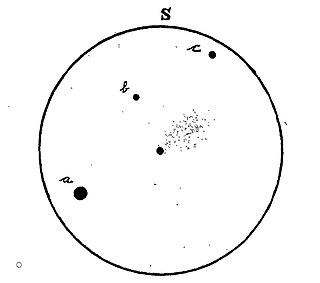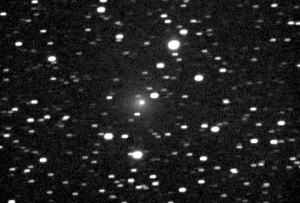Related Research Articles

Comet 4P/Faye is a periodic Jupiter-family comet discovered in November 1843 by Hervé Faye at the Royal Observatory in Paris. Its most recent perihelia were on November 15, 2006; May 29, 2014; and September 8, 2021.

10P/Tempel, also known as Tempel 2, is a periodic Jupiter-family comet with a 5 year orbital period. It was discovered on July 4, 1873 by Wilhelm Tempel. The next perihelion passage is 2 August 2026 when the comet will have a solar elongation of 164 degrees at approximately apparent magnitude 8. Closest approach to Earth will be one day later on 3 August 2026 at a distance of 0.414 AU (61.9 million km).

28P/Neujmin, also known as Neujmin 1, is a large periodic comet in the Solar System. With a perihelion distance of 1.5AU, this comet does not make close approaches to the Earth.
36P/Whipple is a periodic comet in the Solar System. It is the lowest numbered Quasi-Hilda comet. It passed 0.25 AU (37 million km) from Jupiter in June 1922.
39P/Oterma is a currently inactive periodic comet with an orbital period of nearly 20 years that stays outside the orbit of Jupiter. The nucleus has a diameter around 4–5 km. It was last observed in August 2021 and came to perihelion in July 2023 while 1.2 AU from Jupiter. It will finish the modest approach to Jupiter in January 2025 and will next come to perihelion in July 2042 at distance of 5.9 AU from the Sun. Opposition has occurred on 11 November 2023.

52P/Harrington–Abell is a periodic comet in the Solar System.

74P/Smirnova–Chernykh is a periodic comet in the Solar System. It fits the definition of an Encke-type comet with, and is a Quasi-Hilda comet. It was discovered in late March 1975 by Tamara Mikhajlovna Smirnova while examining exposures from the Crimean Astrophysical Observatory. In the discovery images the comet had an apparent magnitude of ~15. In the year of discovery, the comet came to perihelion on August 6, 1975.

77P/Longmore is a periodic comet in the Solar System, with a period of 6.8 years.

78P/Gehrels, also known as Gehrels 2, is a Jupiter-family periodic comet in the Solar System with a current orbital period of 7.22 years.

Comet Finlay is a periodic comet with an orbital period of 6 years discovered by William Henry Finlay on September 26, 1886. The next perihelion passage is July 13, 2021 when the comet will have a solar elongation of 54 degrees at approximately apparent magnitude 10. It last came to perihelion on December 27, 2014, at around magnitude 10. Of the numbered periodic comets, the orbit of 15P/Finlay has one of the smallest minimum orbit intersection distances with the orbit of Earth (E-MOID). In October 2060 the comet will pass about 5 million km from Earth.

Comet Kopff or 22P/Kopff is a periodic comet in the Solar System. Discovered on August 23, 1906, it was named after August Kopff who discovered the comet. The comet was missed on its November 1912 return, but was recovered on its June 1919 return and has been seen at every apparition since. Close approaches to Jupiter in 1938 and 1943 decreased the perihelion distance and orbital period. 22P/Kopff’s last perihelion passage was 18 March 2022. On 13 July 2028 it will pass 0.353 AU (52.8 million km) from Earth.

Comet Schaumasse is a periodic comet discovered by Alexandre Schaumasse on 1 December 1911 as 12th magnitude. It next comes to perihelion on 8 January 2026 and should brighten to about magnitude 9.

68P/Klemola or Klemola's Comet is a periodic comet, which belongs to Jupiter's comet family, that was discovered in 1965 by American astronomer Arnold Richard Klemola in Argentinian Yale-Columbia Southern Station. Its orbital period is 10.82 years.
147P/Kushida–Muramatsu is a quasi-Hilda comet discovered in 1993 by Japanese astronomers Yoshio Kushida and Osamu Muramatsu.

94P/Russell 4 is a periodic comet in the Solar System. It fits the definition of an Encke-type comet with. It was discovered by Ken Rusell on photographic plates taken by M. Hawkins on March 7, 1984. In the discovery images, Russell estimated that the comet had an apparent magnitude of 13 and a noticeable tail of 5 arc minutes. In the year of discovery, the comet had come to perihelion in January 1984.

Comet Arend or 50P/Arend is a periodic comet in the Solar System which was discovered on October 4, 1951. It was discovered by astronomer Sylvain Julien Victor Arend at the Royal Observatory of Belgium located in the municipality of Uccle. The comet was illustrated at approximately a magnitude of 14 and also exhibited a nucleus within a coma 14 arc seconds across. From its discovery, the comet has had 7 perihelions with its last return of Earth recorded on November 1, 2007. The comet's next perihelion will be in the year 2024.

246P/NEAT is a periodic comet discovered on 2004 March 28 by Near-Earth Asteroid Tracking (NEAT) using the 1.2-metre (47 in) reflector at Haleakala. It was given the permanent number 246P on 2011 January 14.
51P/Harrington is a periodic comet in the Solar System.
83D/Russell is a periodic lost comet in the Solar System with an orbital period of about 7.5 years. On the post-1988 orbit the comet probably does not get brighter than about apparent magnitude 21. The comet might come to perihelion in late May 2021, but the uncertainty in the comet's position is a few million km.

104P/Kowal, also known as Kowal 2, is a periodic Jupiter-family comet discovered by Charles T. Kowal in 1979. The orbit was confirmed after new sightings in 1991 and 1998.
References
- 1 2 3 4 5 "JPL Small-Body Database Browser: 82P/Gehrels 3" (2011-03-14 last obs). Jet Propulsion Laboratory. Archived from the original on 2020-07-26. Retrieved 2012-02-18.
- ↑ Seiichi Yoshida (2011-07-03). "82P/Gehrels 3". Seiichi Yoshida's Comet Catalog. Retrieved 2012-02-18.
- ↑ Patrick Rocher (2011-03-23). "Note number : 0090 P/Gehrels 3 : 82P". Institut de mécanique céleste et de calcul des éphémérides . Retrieved 2012-02-19.
- ↑ "Horizons Batch for 82P/Gehrels 3 (90000860) on 2026-Nov-14" (Perihelion occurs when rdot flips from negative to positive). JPL Horizons . Retrieved 2022-06-27. (JPL#19 Soln.date: 2021-Mar-19)
- ↑ "82P/Gehrels 3/publisher= Cometography". Archived from the original on 8 August 2009. Retrieved 24 February 2015.
- ↑ Ohtsuka, K.; Ito, T.; Yoshikawa, M.; Asher, D. J.; Arakida, H. (1 October 2008). "Quasi-Hilda comet 147P/Kushida-Muramatsu. Another long temporary satellite capture by Jupiter". Astronomy and Astrophysics. 489 (3): 1355–1362. arXiv: 0808.2277 . Bibcode:2008A&A...489.1355O. doi:10.1051/0004-6361:200810321. S2CID 14201751.
- ↑ Lamy, P. L.; Toth, I.; Fernandez, Y. R.; Weaver, H. A. (2004). "The sizes, shapes, albedos, and colors of cometary nuclei". In M. C. Festou; H. U. Keller; H. A. Weaver (eds.). Comets II. Bibcode:2004come.book..223L.

